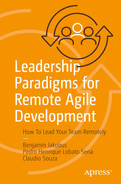Index
A
Accountability
Adaptation
AI-based estimation
Analytical skills
Anchoring Bias
Arrogance
Artistic leaders
Attributes
Autocratic/authoritarian, leadership
Autonomy
B
Bad engineer
Bad feedback
characteristics
vs. good feedback
Bad processes
Bandwagon effect
Behavioral interviews
Biases
Body of Knowledge (BoK)
Bosses and managers
Broken window environment
Broken Window Theory
Bureaucracy
excessive bureaucracy
external
healthy bureaucratic processes
inefficiencies
internal
internal organization
Parkinson’s Law
processes
Bureaucracy reduction
Business intelligence
C
Calibration tests
Career Management
Choice-Supportive Bias
Collaboration
Communication
context
cultural and behavioral red lines
Conductors
Confirmation bias
Consumer engagement
Cost of bad engineers
Cost of hiring
COVID-19 pandemic
Cult of personality
Customer satisfaction
D
DACI
Decision making
Decision-making framework
Democratic leadership
Direct costs
Directly Responsible Individuals (DRIs)
Dishonesty
Diversity
Diversity, Equity, and Inclusion (DEI)
Documented processes
Dunning-Kruger effect
Dysfunctional teams
E
Effective organization
Empathy
Empirical Knowledge
Engagement
Engineering Manager (EMs)
Enthusiasm
Equity
Ethical behavior
Ethics
building strong ethical position
cult of personality
Lucifer effect
market incentives
personal identity and accountability
words
Excessive bureaucracy
Expectation alignment
Expectation management
Expectations
insufficient information
situational
unrealistic expectations
See alsoUnrealistic expectations
in working environment
Experience
Experimentation
External bureaucracy
F
Facilitation
Facilitators
False expectations
Feedback
acting
asking for feedback
bad feedback
SeeBad feedback
criticism
definition
good feedback
SeeGood feedback
labeling theory
listening
1:1 meetings
password
planned feedback
responding to negative feedback
self-awareness
template questions
validation
words of caution
Flame war
Focus
G
Good communication skills
Good feedback
characteristics
participation
planning
private/public
regular
relevant
specific
Good processes
Good software engineers
Good trust
Good written communication
H
Healthy bureaucratic processes
Hierarchies
Hiring
“bad engineer” checklist
career cycle
direct costs
Dunning-Kruger effect
experience
“good engineer” checklist
honesty
indirect costs
and retention
right people
SeeRight people
Hiring good engineers
hiring scoreboard
interviewing process
recruiter screening
scheduling
staffing requirements
technical screening
tooling
Hiring scoreboard
Honesty
Horizontal organization
1-hour long systems design question
Human dynamics
Humility
I
Imaginary predictability
Inclusion
Incompetence
Inertia
Insufficient/incorrect information
Internal bureaucracy
Interviewing
Interview process
Intuitive Knowledge
J
Justifiable
Just-in-time production (JIT)
K
Kanban
Key Performance Indicators (KPIs)
L
Labeling theory
Leaders
accountability
analogy
communication
courage
definition
followers
guidance and orchestration
hiring person
key practices
knowledge
management
vs. managers
professional working
skill
traits
work relationships
Leadership
core
OnCall issues
situations
styles
Lean Construction
Lean Higher Education
Lean inception (LIs)
Lean Manufacturing
Lean Software Development
Listening
Lucifer effect
M
Management
Managers
autonomy
deadlines
EMs
facilitation
vs. leaders
management framework
mistakes
overseeing
shielding
Manufacturing process
Market incentives
MBA-Syndrome
Methodologies
75-minute long technical screening
Misaligned interests
Morale erosion
MRI machines
N
Naive realism
O
Objectives and Key Results (OKRs)
Obsession with metrics
One-on-one (1:1) meetings
Openness
Operational security
Orchestra
Overseeing
P
Parkinson’s Law
People
Practices
Prioritization
Processes
Process owners
Process review
Product development
Product managers (PMs)
Products
main pillar
successful
unsuccessful
Project Management
EMs
planning/prioritization
brains
communication
companies
focusing, solution
future
limited perspective
software development
static views
stories
right thing, building
Projects
core team selection
Liftoff Meetings
LIs
stakeholders
team
milestones
notes
sprint
stakeholders
stories
success metrics
Q
Quality
code quality and operational security
hierarchies
processes
slowing down
trust and autonomy
R
Rational Knowledge
Realistic expectations
Recognition
Remote agile teams
bureaucracy reduction
ethics
expectation management
focus
leadership
people
pillars
quality
Remote communication
Remote setting
Remote work
collaboration
communication
trust
SeeTrust
work-life balance
Retention
Revealed Knowledge
Right people
additional systems-design interview round
anticipating problems
behaviors, bad engineer
complex take-home exercise
good analytical skills
good communication skills
humble and self-conscious
technical interview
technical knowledge
S
Sad truth
Scope creep
SCRUM
Self-awareness
Sensitive data
Servant leadership
Shielding
Situation Awareness (SA)
Social hierarchy
Software Development Life Cycle (SDLC) processes
Software development teams
Software engineering
Software engineers
Software vs. physical products
Solidification
Stanford Prison Experiment
Successful bureaucracy
Successful technical interviews
golden rules
Sympathy
T
Teachers
Team members
Technical interviews
Textual communication
The Toyota Way
Time-Beater
Toyota Production System (TPS)
Traits
Transactional leadership
Transformational leadership
Trust
honesty
openness
recognition
U
Uncertainty
Unfeasible deadlines
Unmatched autonomy
Unmatched expectations
Unrealistic expectations
aligned expectations
communication
impacts
project-related
scope creep
unfeasible deadlines
unmatched autonomy
V
Verification and Validation (V&V)
W, X, Y, Z
Waterfall development
Weakening mental workload
Weak ethical positions
Working from home
Work-life balance
Written commitments
..................Content has been hidden....................
You can't read the all page of ebook, please click here login for view all page.
